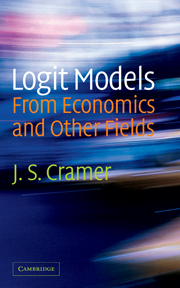Book contents
- Frontmatter
- Contents
- List of figures
- List of tables
- Preface
- 1 Introduction
- 2 The binary model
- 3 Maximum likelihood estimation of the binary logit model
- 4 Some statistical tests and measures of fit
- 5 Outliers, misclassification of outcomes, and omitted variables
- 6 Analyses of separate samples
- 7 The standard multinomial logit model
- 8 Discrete choice or random utility models
- 9 The origins and development of the logit model
- Bibliography
- Index of authors
- Index of subjects
2 - The binary model
Published online by Cambridge University Press: 11 January 2010
- Frontmatter
- Contents
- List of figures
- List of tables
- Preface
- 1 Introduction
- 2 The binary model
- 3 Maximum likelihood estimation of the binary logit model
- 4 Some statistical tests and measures of fit
- 5 Outliers, misclassification of outcomes, and omitted variables
- 6 Analyses of separate samples
- 7 The standard multinomial logit model
- 8 Discrete choice or random utility models
- 9 The origins and development of the logit model
- Bibliography
- Index of authors
- Index of subjects
Summary
Binary discrete probability models describe the relation between one or more continuous determining variables and a single attribute. These simple models, probit and logit alike, account for a very large number of practical applications in a wide variety of disciplines, from the life sciences to marketing. In this chapter we discuss their background, their main properties, their justification and their use. Section 2.3 presents the latent variable regression model that is used as the standard derivation throughout this book. Although the emphasis is on the logit model, much of the discussion applies to the probit model as well.
The logit model for a single attribute
The logit model has evolved independently in various disciplines. One of its roots lies in the analysis of biological experiments, where it came in as an alternative to the probit model. If samples of insects are exposed to an insecticide at various levels of concentration, the proportion killed varies with the dosage. For a single animal this is an experiment with a determinate, continuously variable stimulus and an uncertain or random discrete response, viz. survival or death. The same scheme applies to patients who are given the same treatment with varying intensity, and who do or do not recover, or to consumer households with different income levels who respond to this incentive by owning or not owning a car, or by adopting or eschewing some other expensive habit. Married women may or may not take up paid employment and their choice is influenced by family circumstances and potential earnings; students' choices among options of further education are affected by their earlier performance.
Information
- Type
- Chapter
- Information
- Logit Models from Economics and Other Fields , pp. 9 - 32Publisher: Cambridge University PressPrint publication year: 2003
